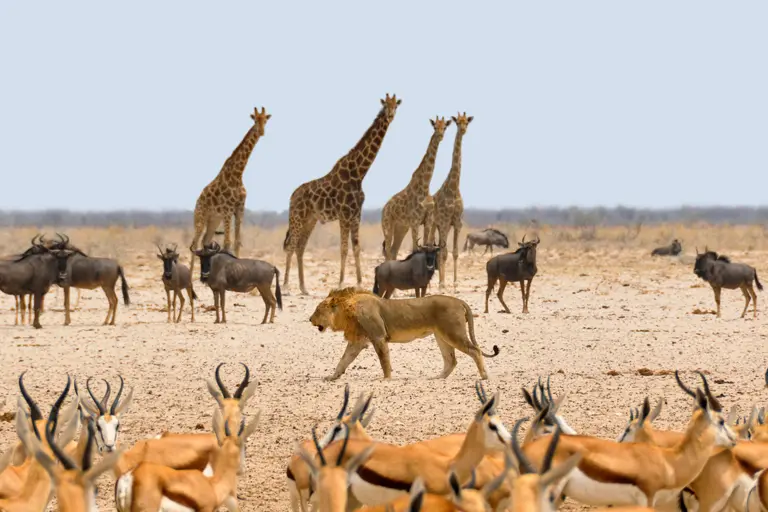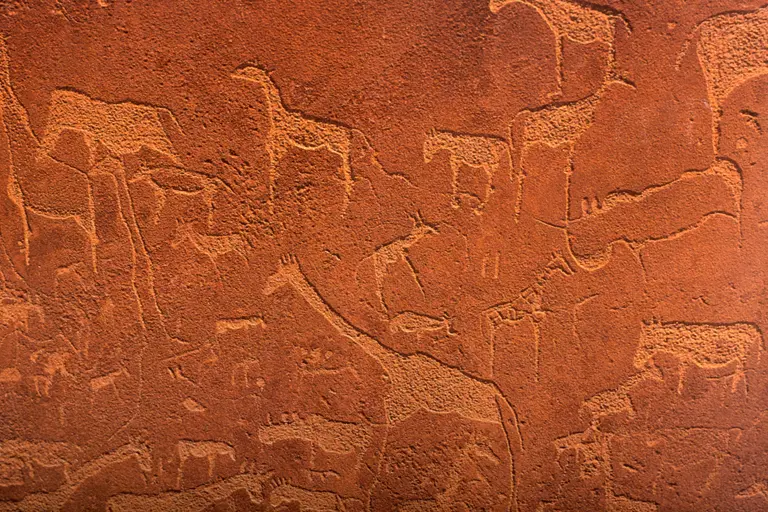





Reasons to Visit Namibia
Desert Landscapes
Wildlife
Desolate Coastline
Namibia is a country located in Southern Africa. It shares borders with Angola and Zambia to the north, Botswana to the east, and South Africa to the south. It is also bordered by the South Atlantic Ocean to the west. The capital city of Namibia is Windhoek, which has a population of approximately 330,000 people.
Namibia covers an area of 824,268 square kilometres, making it slightly larger than half the size of Alaska or nearly four times the size of the UK.
The country's terrain is mostly a high plateau, with the Namib Desert running along the west coast and the Kalahari Desert in the east. The highest point in Namibia is Mount Konigstein, which reaches 2,579 meters in the Brandberg Mountain range.
Namibia has a desert climate, characterized by hot and dry conditions with sparse and erratic rainfall.
Namibia is mostly a high plateau, and it is home to the Namib Desert along the west coast and the Kalahari Desert in the east. The country has a desert climate, with hot and dry conditions and limited rainfall. The highest point in Namibia is Mount Konigstein, reaching 2,579 meters in the Brandberg Mountain range.
Namibia has a diverse range of flora and fauna. The country is known for its abundant wildlife, including various mammal species. There are 240 mammal species in Namibia, with 14 endemic species. The wildlife includes elephants, rhinos, buffalos, giraffes, lions, leopards, cheetahs, hyenas, and many more. Namibia is also home to a wide variety of bird species, with over 676 recorded species, including 11 endemic species.
The flora in Namibia is represented in 14 vegetation zones, with a wide variation in vegetation despite being a desert country. There are around 200 endemic plant species, over 100 species of lichen, 120 species of trees, and unique plant species like the Welwitschia mirabilis, a living fossil plant.
Namibia's economy is based on agriculture, fishing, mining, and tourism. The agricultural sector focuses on beef and meat production, dairy, poultry farming, and fruit production. Due to the country's desert conditions, additional produce is limited, and Namibia relies on imports for many food items.
The mining sector in Namibia is centred around uranium, diamonds, and other minerals like zinc, copper, granite, and marble. Namibia is known for its high-quality diamonds and ranks sixth-highest in the world by value.
Tourism also plays a significant role in Namibia's economy, with the country being a popular destination for wildlife and eco-tourism.
Namibia has a diverse culture and population. The official language of Namibia is English, although Afrikaans is more widely spoken. German is also spoken, reflecting the country's colonial history.
Namibia has a population of approximately 2.5 million people, and it is one of the most sparsely populated countries in the world, with a population density of just 2.4 people per square kilometre.
The capital city, Windhoek, is a vibrant and culturally rich city with a population of around 330,000.
The country has a literacy rate of over 84%, and the life expectancy is around 51 years.
Namibia is known for its commitment to conservation and sustainable eco-tourism, with around 15% of the land being protected, including the entire Namib Desert coastal strip.
Namibia offers a range of tourist attractions. Some highlights include:
Namib Desert: Known for its red sand dunes and stunning landscapes, the Namib Desert offers unique experiences like climbing to the top of a dune in Sossusvlei to witness the fiery red sand-sea.
Fish River Canyon: One of the largest canyons in the world, the Fish River Canyon is a popular hiking destination with breath-taking views.
Etosha National Park: Famous for its wildlife, Etosha National Park is home to various animals, including elephants, lions, rhinos, and giraffes. The massive Etosha Pan, a salt pan, is a prominent feature of the park.
Skeleton Coast: The infamous Skeleton Coast is known for its remote and rugged beauty, offering opportunities for unique experiences and wildlife sightings.
Namibia offers various options for travel, including scheduled tours, self-driving, private-guided safaris, and fly-in safaris. Public transport is not widely available for reaching tourist destinations, so it is recommended to choose one of the mentioned travel options. International flight options are available from regional destinations such as South Africa and Victoria Falls, as well as from Europe and Qatar.
The official language is English, but Afrikaans and German are also widely spoken.
The currency in Namibia is the Namibia Dollar, which is fixed to the South African Rand on a 1:1 basis. Visa and MasterCard are generally accepted in shops and restaurants, but it's advised to carry some cash as well.
Tap water in Namibia is generally safe to drink, but bottled mineral water is also readily available.
It is essential to purchase comprehensive travel insurance that includes medical cover, emergency repatriation, and coverage for cancellation, loss, and personal belongings.
When traveling to Namibia, it is recommended to pack the following:
Neutral-coloured casual clothing suitable for everyday wear, avoiding bright colours or white for game viewing.
Sturdy shoes or robust trainers with good traction soles for walking.
Light jackets or jumpers for summer, and warm jumpers and jackets for winter.
Light spray jacket for traveling between November and April.
Thermal underwear for winter nights.
Sunglasses, torch, and personal toiletries.
Small first aid kit and any necessary personal medications.
Insect repellent and sun lotion.
Credit cards, visas, money, passport, and insurance details.
Binoculars and a refillable water bottle.
Waterproof or dustproof bag for cameras.
Please note that this information is a general guideline, and it's essential to consider personal preferences and specific travel plans when packing.
The electricity voltage in Namibia is 220 volts, and the frequency is 50 Hz. Namibia uses the Type M electrical outlets. Type M outlets have three round pins. If your electrical appliances use a different type of plug, you will need a plug adapter. It's important to check the voltage requirements of your appliances before using them in Namibia. Some appliances may require a voltage converter or transformer for compatibility.
Comprehensive travel insurance is mandatory when booking a trip to Namibia. The insurance should cover full medical expenses, emergency repatriation, cancellation, and protection against loss, damage, and theft of personal belongings. It is the traveller's responsibility to arrange appropriate insurance and ensure they have read and understood the full terms and conditions of the policy.
